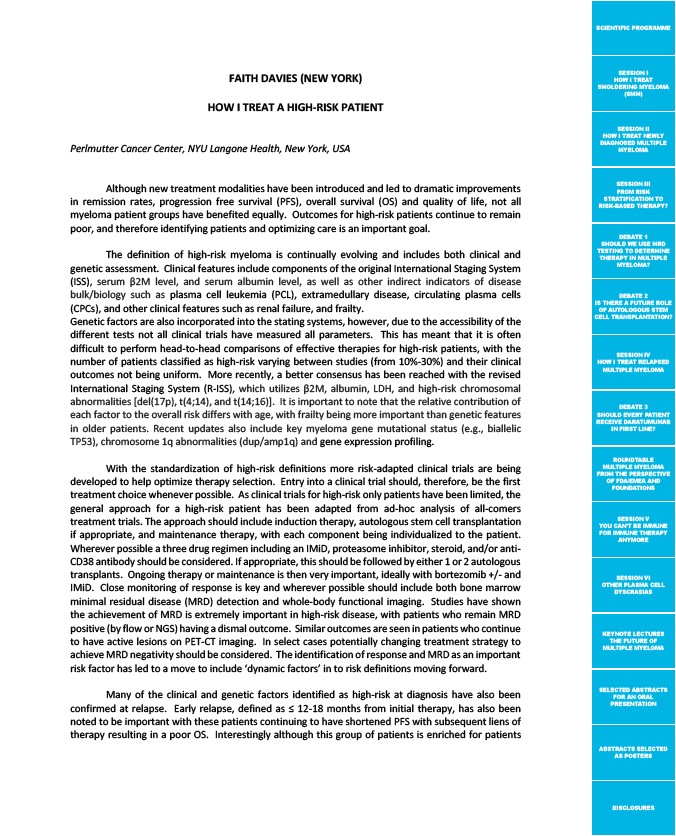
SCIENTIFIC PROGRAMME
SESSION I
HOW I TREAT
SMOLDERING MYELOMA
(SMM)
SESSION II
HOW I TREAT NEWLY
DIAGNOSED MULTIPLE
MYELOMA
SESSION III
FROM RISK
STRATIFICATION TO
RISK-BASED THERAPY?
DEBATE 1
SHOULD WE USE MRD
TESTING TO DETERMINE
THERAPY IN MULTIPLE
MYELOMA?
DEBATE 2
IS THERE A FUTURE ROLE
OF AUTOLOGOUS STEM
CELL TRANSPLANTATION?
SESSION IV
HOW I TREAT RELAPSED
MULTIPLE MYELOMA
DEBATE 3
SHOULD EVERY PATIENT
RECEIVE DARATUMUMAB
IN FIRST LINE?
ROUNDTABLE
MULTIPLE MYELOMA
FROM THE PERSPECTIVE
OF FDA/EMEA AND
FOUNDATIONS
SESSION V
YOU CAN’T BE IMMUNE
FOR IMMUNE THERAPY
ANYMORE
SESSION VI
OTHER PLASMA CELL
DYSCRASIAS
KEYNOTE LECTURES
THE FUTURE OF
MULTIPLE MYELOMA
SELECTED ABSTRACTS
FOR AN ORAL
PRESENTATION
ABSTRACTS SELECTED
AS POSTERS
DISCLOSURES
FAITH DAVIES (NEW YORK)
HOW I TREAT A HIGH-RISK PATIENT
Perlmutter Cancer Center, NYU Langone Health, New York, USA
Although new treatment modalities have been introduced and led to dramatic improvements
in remission rates, progression free survival (PFS), overall survival (OS) and quality of life, not all
myeloma patient groups have benefited equally. Outcomes for high-risk patients continue to remain
poor, and therefore identifying patients and optimizing care is an important goal.
The definition of high-risk myeloma is continually evolving and includes both clinical and
genetic assessment. Clinical features include components of the original International Staging System
(ISS), serum β2M level, and serum albumin level, as well as other indirect indicators of disease
bulk/biology such as plasma cell leukemia (PCL), extramedullary disease, circulating plasma cells
(CPCs), and other clinical features such as renal failure, and frailty.
Genetic factors are also incorporated into the stating systems, however, due to the accessibility of the
different tests not all clinical trials have measured all parameters. This has meant that it is often
difficult to perform head-to-head comparisons of effective therapies for high-risk patients, with the
number of patients classified as high-risk varying between studies (from 10%-30%) and their clinical
outcomes not being uniform. More recently, a better consensus has been reached with the revised
International Staging System (R-ISS), which utilizes β2M, albumin, LDH, and high-risk chromosomal
abnormalities del(17p), t(4;14), and t(14;16). It is important to note that the relative contribution of
each factor to the overall risk differs with age, with frailty being more important than genetic features
in older patients. Recent updates also include key myeloma gene mutational status (e.g., biallelic
TP53), chromosome 1q abnormalities (dup/amp1q) and gene expression profiling.
With the standardization of high-risk definitions more risk-adapted clinical trials are being
developed to help optimize therapy selection. Entry into a clinical trial should, therefore, be the first
treatment choice whenever possible. As clinical trials for high-risk only patients have been limited, the
general approach for a high-risk patient has been adapted from ad-hoc analysis of all-comers
treatment trials. The approach should include induction therapy, autologous stem cell transplantation
if appropriate, and maintenance therapy, with each component being individualized to the patient.
Wherever possible a three drug regimen including an IMiD, proteasome inhibitor, steroid, and/or anti-
CD38 antibody should be considered. If appropriate, this should be followed by either 1 or 2 autologous
transplants. Ongoing therapy or maintenance is then very important, ideally with bortezomib +/- and
IMiD. Close monitoring of response is key and wherever possible should include both bone marrow
minimal residual disease (MRD) detection and whole-body functional imaging. Studies have shown
the achievement of MRD is extremely important in high-risk disease, with patients who remain MRD
positive (by flow or NGS) having a dismal outcome. Similar outcomes are seen in patients who continue
to have active lesions on PET-CT imaging. In select cases potentially changing treatment strategy to
achieve MRD negativity should be considered. The identification of response and MRD as an important
risk factor has led to a move to include ‘dynamic factors’ in to risk definitions moving forward.
Many of the clinical and genetic factors identified as high-risk at diagnosis have also been
confirmed at relapse. Early relapse, defined as ≤ 12-18 months from initial therapy, has also been
noted to be important with these patients continuing to have shortened PFS with subsequent liens of
therapy resulting in a poor OS. Interestingly although this group of patients is enriched for patients